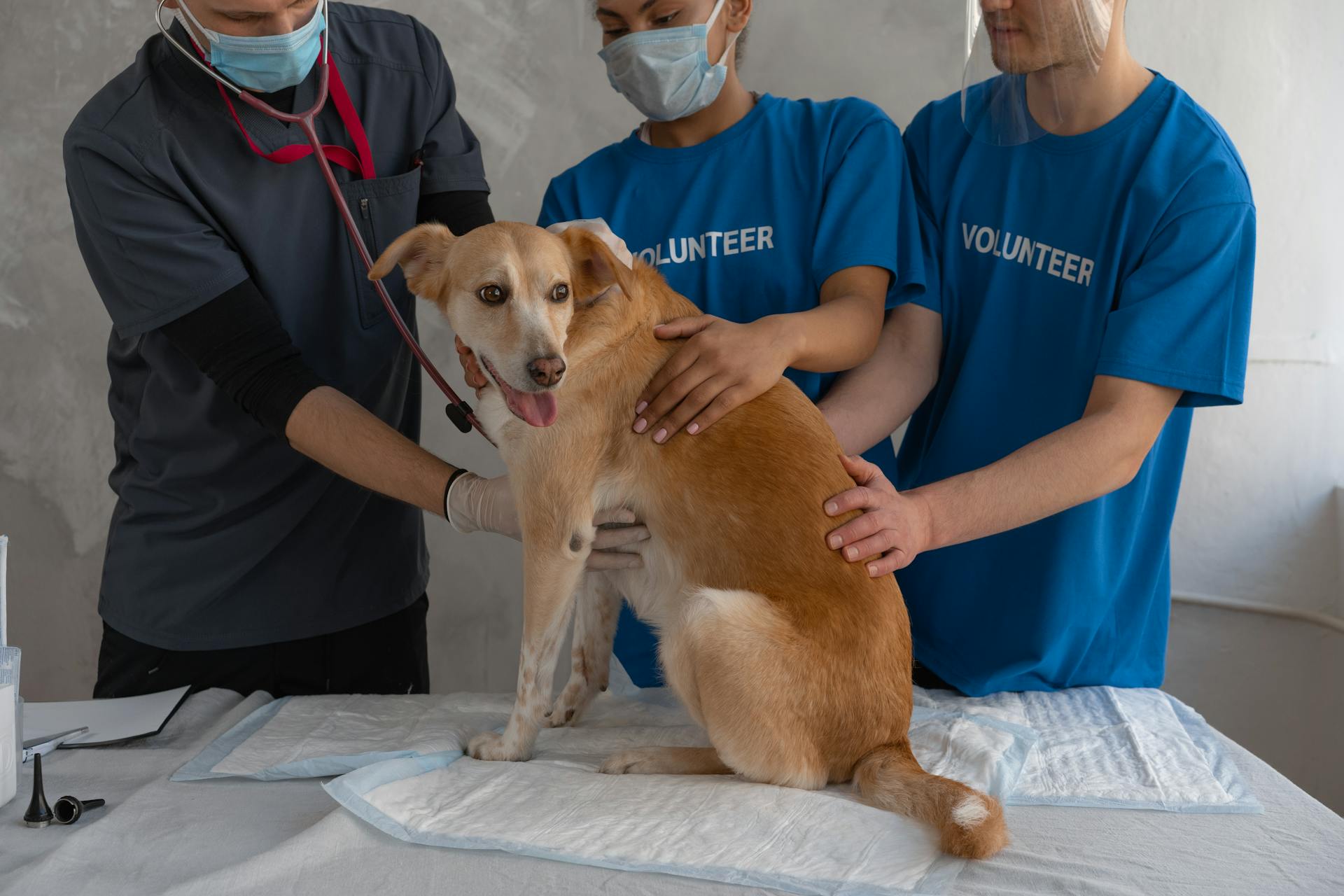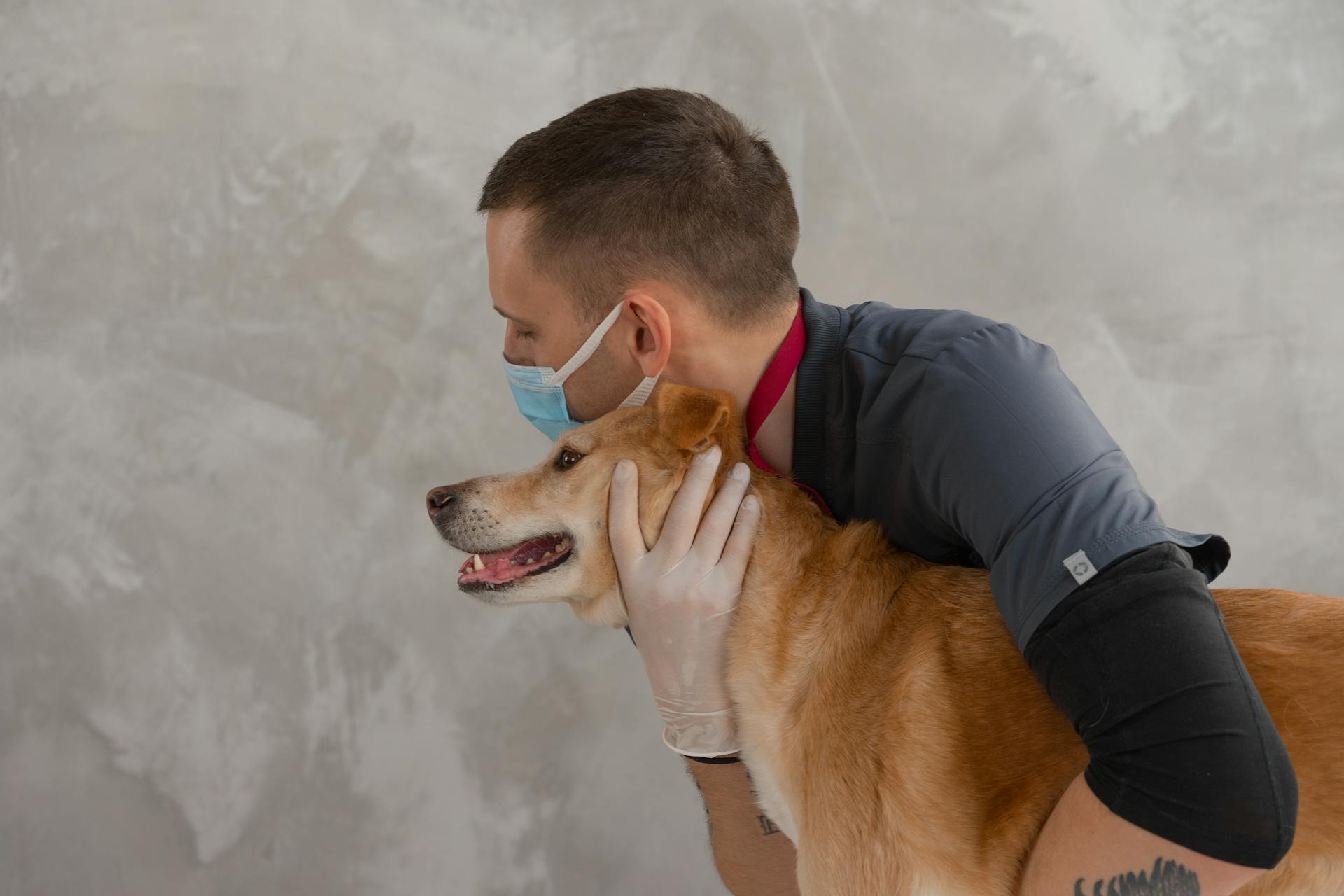
Hemorrhagic gastroenteritis in dogs is a serious condition that requires immediate attention. It's characterized by severe vomiting and diarrhea, often accompanied by blood in the stool.
The exact cause of hemorrhagic gastroenteritis in dogs is still unknown, but it's believed to be related to a viral or bacterial infection. This condition can affect any dog, but it's more common in smaller breeds.
Symptoms of hemorrhagic gastroenteritis can appear suddenly, often within a 24-hour period. Dogs may also experience lethargy, loss of appetite, and abdominal pain.
In most cases, hemorrhagic gastroenteritis in dogs is not contagious, but it can be spread through contact with an infected dog's feces or vomit.
See what others are reading: Hemorrhagic Gastroenteritis in Dogs
What is HGE in Dogs?
HGE in dogs is a serious condition that affects their digestive system. It's characterized by diarrhea with a jelly-like consistency and a large amount of black or red blood.
All dogs can develop HGE, regardless of their age, size, or breed. However, small dogs are at a higher risk, and those with a medical history of stomach sensitivity are more likely to experience it frequently.
Dogs who have HGE may be lethargic, have a reduced appetite, and react if touched on their abdomen due to the pain and discomfort. They may lash out or bite if they're sore and uncomfortable.
HGE is not a contagious disease and cannot be transmitted from dog to dog. However, the underlying cause of HGE may be contagious, but more research is needed to confirm this hypothesis.
Here are some common breeds that are more prone to HGE:
- Yorkshire Terriers
- Miniature Poodles
- Miniature Schnauzers
- Cavalier King Charles Spaniels
- Maltese Terriers
- Bichon Frise
- Labrador Retrievers
Causes and Symptoms
Hemorrhagic gastroenteritis in dogs is a serious condition that requires prompt attention. The exact cause is currently unknown, but one of the most common causes is thought to be a result of infection by Clostridium perfringens bacteria.
Some symptoms of this condition include bloody diarrhea, vomiting, dehydration, lethargy, lack of appetite, depression, pain in the abdomen, and fever. These symptoms can be alarming, and it's essential to seek medical attention if you notice any of them in your dog.
The most common signs owners notice are vomiting and diarrhea with blood present. Other subtle clinical signs can occur before or alongside these symptoms, including a reduction in appetite, lethargy, painful abdomen, fever, weakness, dehydration, and collapse.
Here are some key symptoms to look out for:
- Bloody diarrhea
- Vomiting
- Dehydration
- Lethargy
- Painful abdomen
- Fever
Common Causes of Disease in Dogs
Hemorrhagic gastroenteritis can affect any dog, but it's more commonly seen in small and toy dog breeds. Commonly affected breeds include Yorkshire Terriers, Miniature Poodles, Miniature Schnauzers, Cavalier King Charles Spaniels, Maltese Terriers, Bichon Frise, and Labrador Retrievers.
The exact cause of hemorrhagic gastroenteritis is still unknown, but it's thought to be linked to bacteria that target the cells that line the gut.
One of the most common causes is believed to be a result of infection by Clostridium perfringens bacteria. This type of bacteria can cause a range of symptoms, including bloody diarrhea, vomiting, and lethargy.
To assess if your dog is dehydrated at home, try to lift the skin at the scruff of their neck. If the skin "tents" upwards and doesn't return to its original position, it's an indication of dehydration.
Here are some signs of dehydration to look out for:
- Nose is dry
- Starts panting
- Gums feel dry and sticky
If your dog is dehydrated, it can become sick in a short space of time. If you suspect your dog has become dehydrated, it's essential to seek veterinary attention as soon as possible.
Expand your knowledge: How to Become a Dog Trainer for Service Dogs
What Are

What Are the Key Factors Involved in Causes and Symptoms?
ADHD is a neurodevelopmental disorder characterized by symptoms of inattention, hyperactivity, and impulsivity.
Research suggests that genetics play a significant role in the development of ADHD, with studies indicating that 70-80% of cases have a strong familial link.
Structural and functional differences in the brain, particularly in the prefrontal cortex and basal ganglia, have been identified in individuals with ADHD.
Executive function deficits, including difficulties with planning, organization, and self-regulation, are also a hallmark of the disorder.
Explore further: Hemorrhagic Gastroenteritis Symptoms
Diagnosis and Treatment
If your dog is showing symptoms of hemorrhagic gastroenteritis, you should take them to a vet right away.
The veterinarian may perform a urinalysis and complete blood count to help eliminate other causes of the diarrhea and vomiting.
A blood test will likely confirm the diagnosis, revealing elevated packed cell volume (PCV) levels, which indicate a high percentage of red blood cells in the blood volume.
If your dog is diagnosed with HGE, they will likely spend a day at the hospital receiving treatment.
Intravenous fluid therapy is essential in treating dogs with HGE, as it helps prevent dehydration and the thickening of the blood.
Your vet will monitor your dog's PCV and electrolyte levels after fluid therapy to ensure they are recovering properly.
A unique perspective: Service and Therapy Dogs
Diagnosis
A diagnosis of hemorrhagic gastroenteritis in dogs is typically made by a veterinarian based on your dog's symptoms and clinical history.
The veterinarian may perform a packed cell volume (PCV) blood test to check for a high PCV level, which is a sign of concern at 55% or higher.
A normal PCV/HCT level is between 37% and 55%.
The veterinarian may also conduct fecal testing and X-rays to rule out other conditions that cause similar symptoms.
These conditions include pancreatitis and the parvovirus.
A blood test can confirm the diagnosis by revealing elevated PCV levels.
A high PCV indicates that the percentage of red blood cells present in the blood volume is too high compared to the amount of fluid.
Low total protein levels and acute bloody diarrhea also form the basis for a diagnosis of hemorrhagic gastroenteritis.
You might enjoy: Dog Food for High Energy Dogs
Dogs: Treatment Options
Dogs with Hemorrhagic Gastroenteritis (HGE) often require hospitalization to receive treatment.
The vet will administer large amounts of fluids to your dog through an intravenous catheter to prevent dehydration and thickening of the blood.
Your dog will also be given antibiotics and medications to prevent nausea.
Intravenous fluid therapy is essential in the treatment of dogs with HGE, and if not given aggressively, your dog will become more dehydrated.
Monitoring your dog's PCV and electrolyte levels after fluid therapy is crucial to ensure the treatment is effective.
Disseminated intravascular coagulation, a clotting disorder, can be fatal if left untreated, so it's essential to seek veterinary care immediately if your dog is showing symptoms of HGE.
Identifying HGE in Dogs
HGE, or hemorrhagic gastroenteritis, can be identified by its distinctive symptoms. Dogs with HGE typically experience diarrhea with a jelly-like consistency and a large amount of black or red blood.
Small dogs are at a higher risk of developing HGE, and dogs with a medical history of stomach sensitivity are also more likely to experience HGE frequently.
The condition can affect any breed or age of dog, but it's more commonly seen in small and toy dog breeds. Some commonly affected breeds include Yorkshire Terriers, Miniature Poodles, and Cavalier King Charles Spaniels.
The main signs to look out for are acute onset vomiting and diarrhea with a large amount of blood in the diarrhea. If your dog is experiencing these symptoms, it's essential to seek veterinary attention immediately.
To assess if your dog is dehydrated, you can try lifting the skin at the scruff of their neck. If the skin "tents" upwards and doesn't return to its original position, it's an indication of dehydration.
Here are some signs of dehydration to look out for:
- Reduced appetite or complete loss of appetite
- Lethargy
- Painful abdomen
- Fever
- Weakness
- Dehydration
- Collapse
If you suspect your dog has become dehydrated, it's crucial to act quickly and seek veterinary attention.
Frequently Asked Questions
Can dogs catch gastroenteritis from other dogs?
Yes, dogs can catch gastroenteritis from other dogs through direct contact, as well as through contaminated surfaces and water. This highly contagious virus can spread quickly among dogs.
Is gastroenteritis in dogs contagious to humans?
Yes, gastroenteritis in dogs can be contagious to humans if proper hygiene practices are not followed. Washing your hands frequently, especially after interacting with dogs, is crucial to preventing the spread of infection.
Sources
- https://www.merckvetmanual.com/digestive-system/diseases-of-the-stomach-and-intestines-in-small-animals/acute-hemorrhagic-diarrhea-syndrome-in-dogs
- https://www.webmd.com/pets/dogs/what-is-hemorrhagic-gastroenteritis-dogs
- https://wagwalking.com/condition/hemorrhagic-gastroenteritis
- https://www.kingsdale.com/hge-in-dogs-hemorrhagic-gastroenteritis
- https://www.dogster.com/ask-the-vet/hge-hemorrhagic-gastroenteritis-in-dogs
Featured Images: pexels.com

